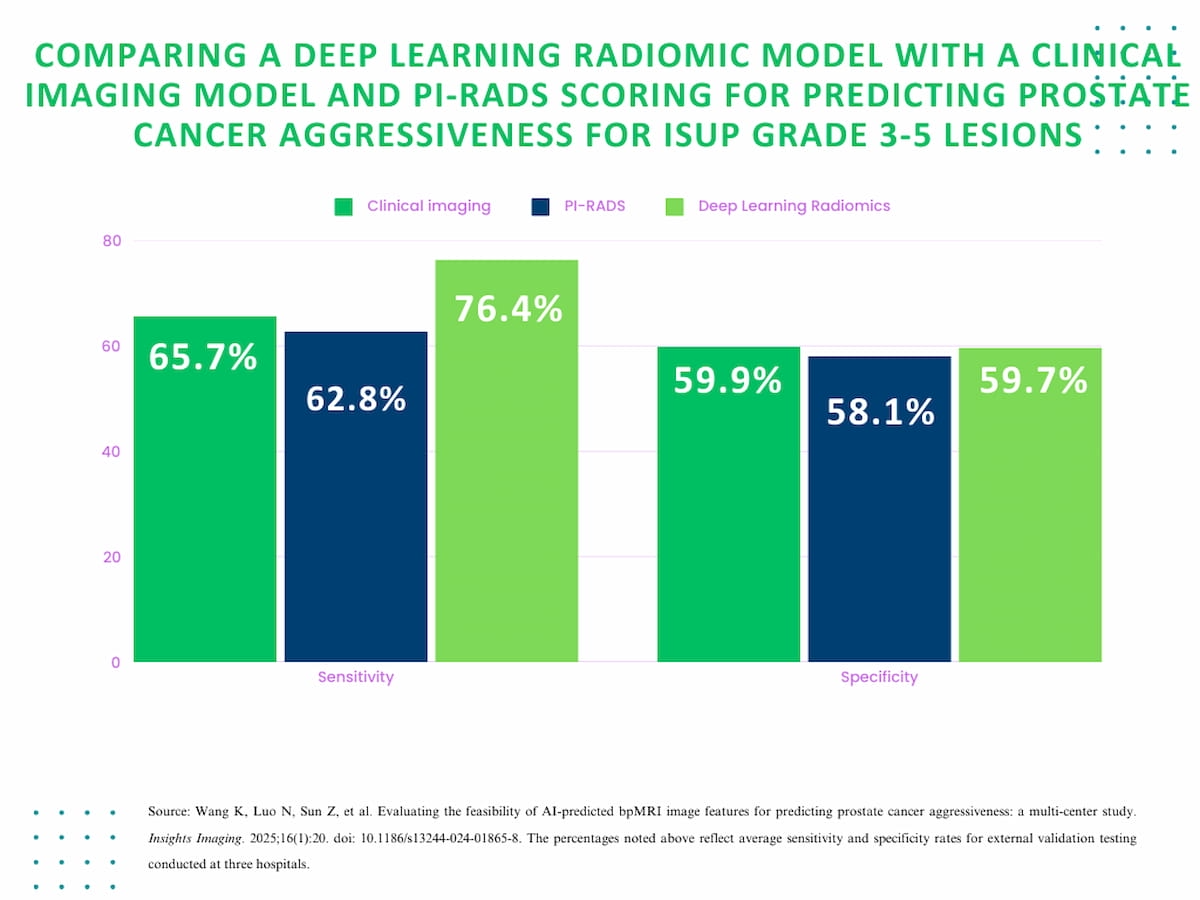Based on biparametric magnetic resonance imaging (bpMRI) scans, a deep learning radiomic model may provide a significantly higher area under the curve (AUC) and sensitivity rate for the prognosis of prostate cancer in comparison to PI-RADS scoring.
In new research, recently published in Insights into Imaging, researchers compared the aforementioned deep learning radiomic model to a conventional radiomic model, a clinical imaging model, PI-RADS scoring and biopsy pathology in 878 patients with prostate cancer (PCa) who underwent radical prostatectomy procedures. The training set was comprised of 345 patients with the remaining 533 patients being assessed in external validation testing, according to the study.
The researchers found that the deep learning radiomic model had an overall AUC range between 70 to 79.1 percent in external validation testing for predicting PCa progression in comparison to a range of 59.7 to 71.8 percent for the clinical imaging model and a range of 55.4 to 61.3 percent for PI-RADS scoring.
For the prognostic assessment of International Society of Urological Pathology (ISUP) grade 3-5 lesions, external validation testing revealed nearly equivalent average specificity between the deep learning radiomics model (59.7 percent), the clinical imaging model (59.9 percent) and PI-RADS scoring (58.1 percent).
(Editor's note: For related content on MRI, click here.)
However, for these patients, the study authors noted over a 10 percent higher sensitivity for the deep learning radiomics model (76.4 percent) in contrast to the clinical imaging model (65.7 percent) and PI-RADS scoring (62.8 percent).
“Our study showed that the radiomics model based on deep learning is promising for providing an objective and non-invasive method for evaluating the invasiveness of PCa, which is helpful for further reducing overtreatment and avoiding unnecessary biopsy and has a certain generalizability,” wrote study co-author ZiXuan Kong, M.D., who is affiliated with the Department of Radiology at the Second Affiliated Hospital of Dalian Medical University in Dalian, China, and colleagues.
Three Key Takeaways
1. Enhanced prognostic accuracy. The deep learning radiomics model demonstrated superior predictive performance for prostate cancer progression, with higher sensitivity and area under the curve (AUC) compared to PI-RADS scoring and the clinical imaging model, particularly for higher-grade lesions (ISUP grade 3-5).
2. Potential to reduce over treatment. By offering a non-invasive and objective assessment of prostate cancer invasiveness, the deep learning radiomic model may help avoid unnecessary biopsies and over treatment, improving patient management strategies.
3. Generalizability across settings. The deep learning radiomic model exhibited strong consistency in PCa prognosis across different hospitals, MRI scanners, and imaging parameters, indicating robust generalizability despite study limitations such as cohort size and lesion categorization.
The study authors also found the deep learning radiomics model showed higher AUC consistency in external validation at the three reviewing hospitals for ISUP grade 2 lesions (range of 69.6 to 72.5 percent) and ISUP grade 3 to 5 lesions (range of 71.3 to 77 percent).
“In this study, there was no statistically significant difference in the prediction of ISUP grouping of PCa lesions by the in-depth learning radiomics model among the three external hospitals, indicating that the model has strong generalizability among different hospitals, different MRI scanners, different field strengths, and different scanning parameters,” posited Kong and colleagues.
(Editor’s note: For related content, see “Can Generative AI Facilitate Simulated Contrast Enhancement for Prostate MRI?,” “Can MRI-Based AI Enhance Risk Stratification in Prostate Cancer?” and “Study Emphasizes PSMA PET Staging of High-Risk, Hormone Sensitive Prostate Cancer.”)
In regard to study limitations, the authors acknowledged a relatively small cohort size and a lack of categorization of PCa lesions based on peripheral zone or transitional zone location.
